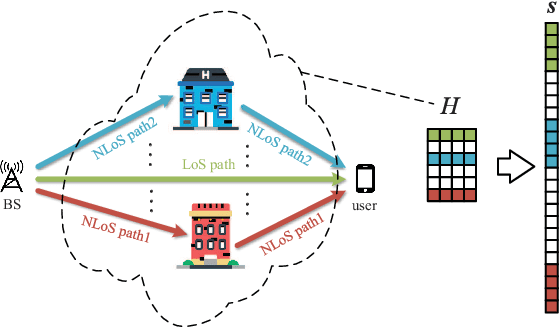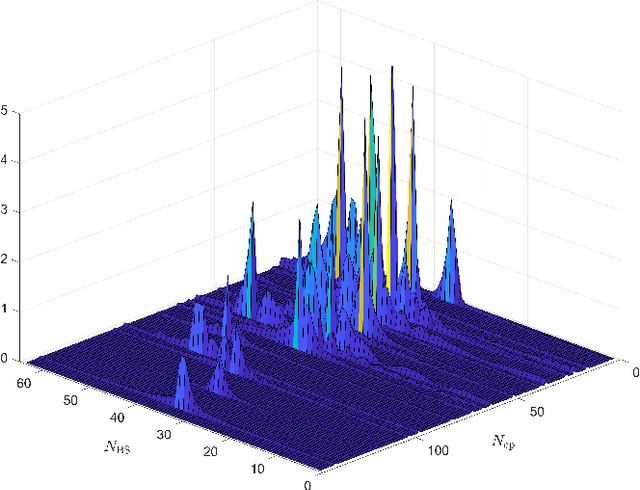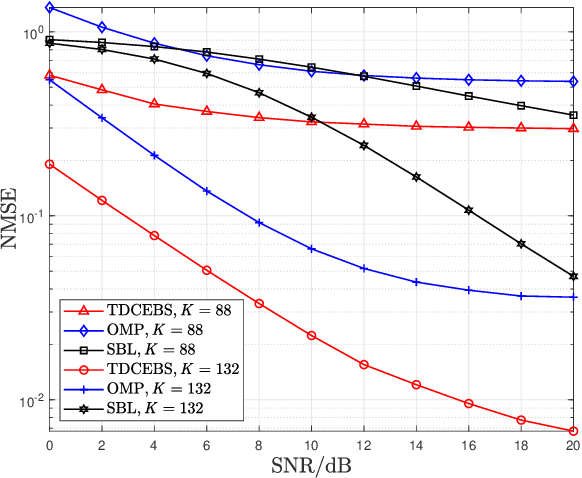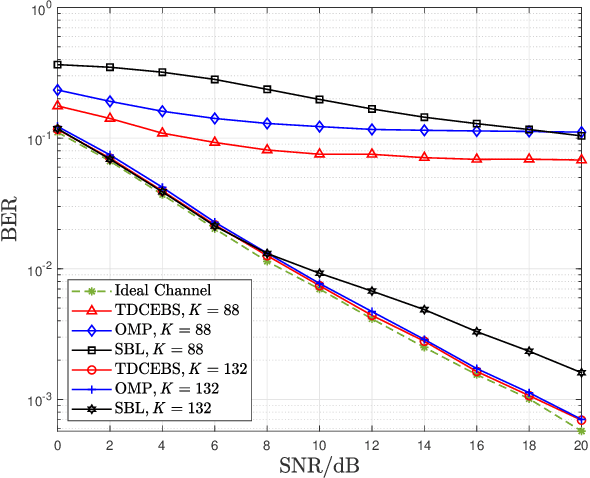Zhaohua Lu
Revealing the evanescent components in Kronecker-product based codebooks: insights and implications
Jul 09, 2024Abstract:The orthogonal bases of discrete Fourier transform (DFT) has been recognized as the standard spatial-domain bases for Type I, Type II and enhanced Type II codewords by the 3rd Generation Partnership Project (3GPP). For uniform planar arrays, these spatial-domain bases are derived as the Kronecker product of one-dimensional DFT bases. Theoretically, each spatial basis corresponds to a beam directed towards a specific angle of departure and the set of bases represent the orthogonal beams that cover the front hemisphere of an array. While the Kronecker-product based precoding scheme facilitates the concise indexing of a codeword in the codebooks through precoding matrix indicators (PMIs) in channel state information feedback, it introduces redundant spatial beams characterized by high spatial-frequency components. This paper investigates the presence of codewords representing high spatial-frequency components within the Kronecker-product based codebooks. Through theoretical analysis and simulations, we confirm the redundancy of these codewords in MIMO communications, advocating for their removal from the codebooks to enhance system performance. Several topics relevant to the high spatial components are also involved in the discussion. Practical suggestions regarding future standard design are provided based on our theoretical analysis and simulation results.
Entropy-based Probing Beam Selection and Beam Prediction via Deep Learning
Jan 03, 2024Abstract:Hierarchical beam search in mmWave communications incurs substantial training overhead, necessitating deep learning-enabled beam predictions to effectively leverage channel priors and mitigate this overhead. In this study, we introduce a comprehensive probabilistic model of power distribution in beamspace, and formulate the joint optimization problem of probing beam selection and probabilistic beam prediction as an entropy minimization problem. Then, we propose a greedy scheme to iteratively and alternately solve this problem, where a transformer-based beam predictor is trained to estimate the conditional power distribution based on the probing beams and user location within each iteration, and the trained predictor selects an unmeasured beam that minimizes the entropy of remaining beams. To further reduce the number of interactions and the computational complexity of the iterative scheme, we propose a two-stage probing beam selection scheme. Firstly, probing beams are selected from a location-specific codebook designed by an entropy-based criterion, and predictions are made with corresponding feedback. Secondly, the optimal beam is identified using additional probing beams with the highest predicted power values. Simulation results demonstrate the superiority of the proposed schemes compared to hierarchical beam search and beam prediction with uniform probing beams.
Evaluating Dynamic Conditional Quantile Treatment Effects with Applications in Ridesharing
May 17, 2023



Abstract:Many modern tech companies, such as Google, Uber, and Didi, utilize online experiments (also known as A/B testing) to evaluate new policies against existing ones. While most studies concentrate on average treatment effects, situations with skewed and heavy-tailed outcome distributions may benefit from alternative criteria, such as quantiles. However, assessing dynamic quantile treatment effects (QTE) remains a challenge, particularly when dealing with data from ride-sourcing platforms that involve sequential decision-making across time and space. In this paper, we establish a formal framework to calculate QTE conditional on characteristics independent of the treatment. Under specific model assumptions, we demonstrate that the dynamic conditional QTE (CQTE) equals the sum of individual CQTEs across time, even though the conditional quantile of cumulative rewards may not necessarily equate to the sum of conditional quantiles of individual rewards. This crucial insight significantly streamlines the estimation and inference processes for our target causal estimand. We then introduce two varying coefficient decision process (VCDP) models and devise an innovative method to test the dynamic CQTE. Moreover, we expand our approach to accommodate data from spatiotemporal dependent experiments and examine both conditional quantile direct and indirect effects. To showcase the practical utility of our method, we apply it to three real-world datasets from a ride-sourcing platform. Theoretical findings and comprehensive simulation studies further substantiate our proposal.
Learning-Aided Beam Prediction in mmWave MU-MIMO Systems for High-Speed Railway
Jun 30, 2022



Abstract:The problem of beam alignment and tracking in high mobility scenarios such as high-speed railway (HSR) becomes extremely challenging, since large overhead cost and significant time delay are introduced for fast time-varying channel estimation. To tackle this challenge, we propose a learning-aided beam prediction scheme for HSR networks, which predicts the beam directions and the channel amplitudes within a period of future time with fine time granularity, using a group of observations. Concretely, we transform the problem of high-dimensional beam prediction into a two-stage task, i.e., a low-dimensional parameter estimation and a cascaded hybrid beamforming operation. In the first stage, the location and speed of a certain terminal are estimated by maximum likelihood criterion, and a data-driven data fusion module is designed to improve the final estimation accuracy and robustness. Then, the probable future beam directions and channel amplitudes are predicted, based on the HSR scenario priors including deterministic trajectory, motion model, and channel model. Furthermore, we incorporate a learnable non-linear mapping module into the overall beam prediction to allow non-linear tracks. Both of the proposed learnable modules are model-based and have a good interpretability. Compared to the existing beam management scheme, the proposed beam prediction has (near) zero overhead cost and time delay. Simulation results verify the effectiveness of the proposed scheme.
* 14 pages, 10 figures
Learnable Model-Driven Performance Prediction and Optimization for Imperfect MIMO System: Framework and Application
Jun 30, 2022



Abstract:State-of-the-art schemes for performance analysis and optimization of multiple-input multiple-output systems generally experience degradation or even become invalid in dynamic complex scenarios with unknown interference and channel state information (CSI) uncertainty. To adapt to the challenging settings and better accomplish these network auto-tuning tasks, we propose a generic learnable model-driven framework in this paper. To explain how the proposed framework works, we consider regularized zero-forcing precoding as a usage instance and design a light-weight neural network for refined prediction of sum rate and detection error based on coarse model-driven approximations. Then, we estimate the CSI uncertainty on the learned predictor in an iterative manner and, on this basis, optimize the transmit regularization term and subsequent receive power scaling factors. A deep unfolded projected gradient descent based algorithm is proposed for power scaling, which achieves favorable trade-off between convergence rate and robustness.
Channel Estimation for Wideband MmWave MIMO OFDM System Exploiting Block Sparsity
Mar 12, 2022



Abstract:In this letter, we investigate time-domain channel estimation for wideband millimeter wave (mmWave) MIMO OFDM system. By transmitting frequency-domain pilot symbols as well as different beamforming vectors, we observe that the time-domain mmWave MIMO channels exhibit channel delay sparsity and especially block sparsity among different spatial directions. Then we propose a time-domain channel estimation exploiting block sparsity (TDCEBS) scheme, which always aims at finding the best nonzero block achieving the largest projection of the residue at each iterations. In particular, we evaluate the system performance using the QuaDRiGa which is recommended by 5G New Radio to generate wideband mmWave MIMO channels. The effectiveness of the proposed TDCEBS scheme is verified by the simulation results, as the proposed scheme outperforms the existing schemes.
 Add to Chrome
Add to Chrome Add to Firefox
Add to Firefox Add to Edge
Add to Edge